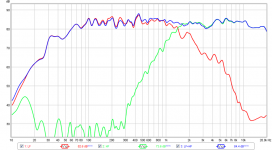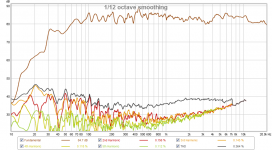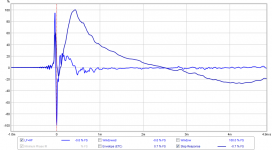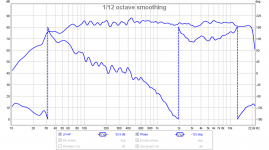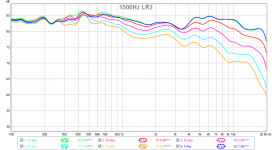If you are really interested in the polar aspect maybe a LR4 is fine for purposes of testing minidsp.
miniDSP Tests
Here is a first cut with a miniDSP. I am using electrical LR2 at 1500Hz low pass on woofer and 1700Hz high pass on tweeter. Strange that there is no cancellation dip - probably because the acoustic shape is not textbook symmetric LR2. A -11dB padding was applied to the tweeter in the waveguide to level match the RS180P. I am using the 4-way advanced plugin, some mild EQ (negative cut only) was applied for shelf and notch filters in a few places.
XO plot:
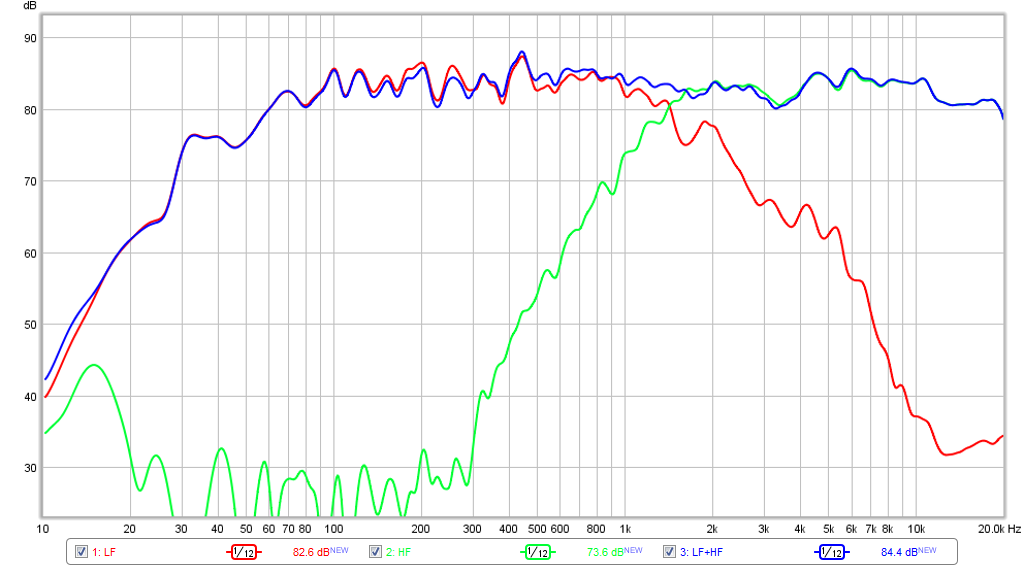
HD plot (2kHz bump is not so bad):
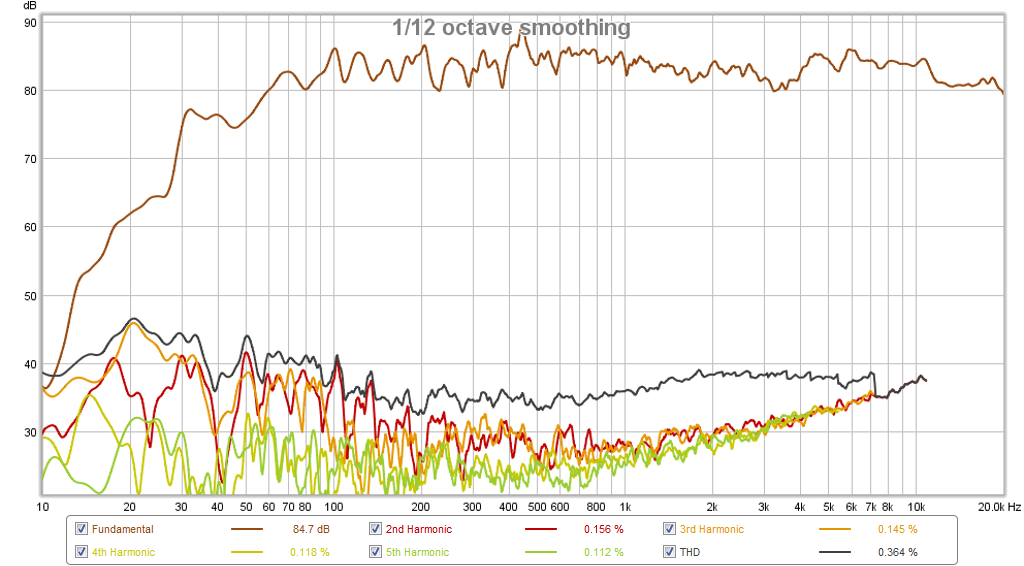
Impulse and Step:
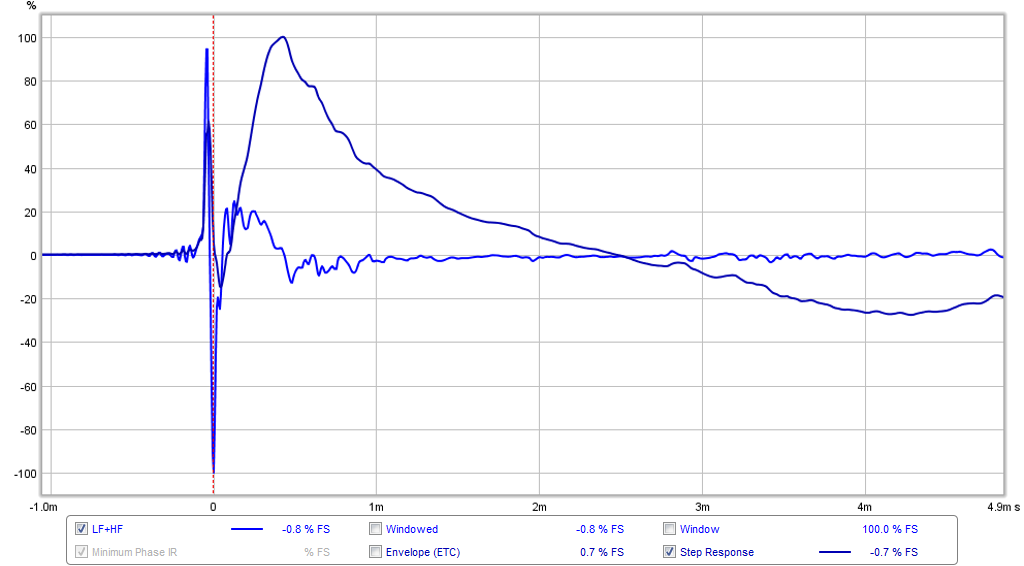
Phase:
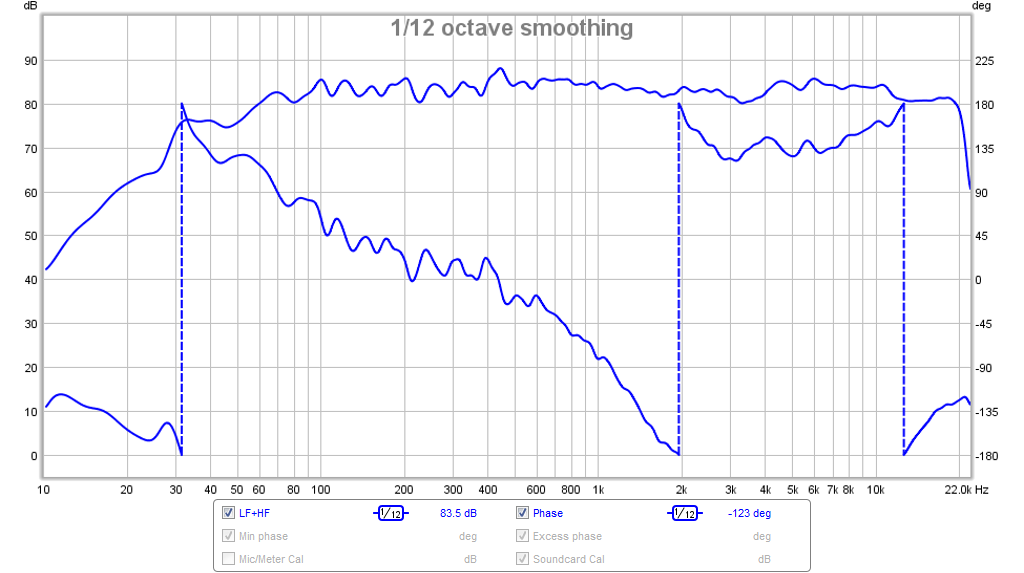
Here is a very rough polar from 0 deg to 75 deg at 0.5m with the above XO. Data presented with 6-cycle frequency dependent window gating (FDW) to remove effects of reflections:
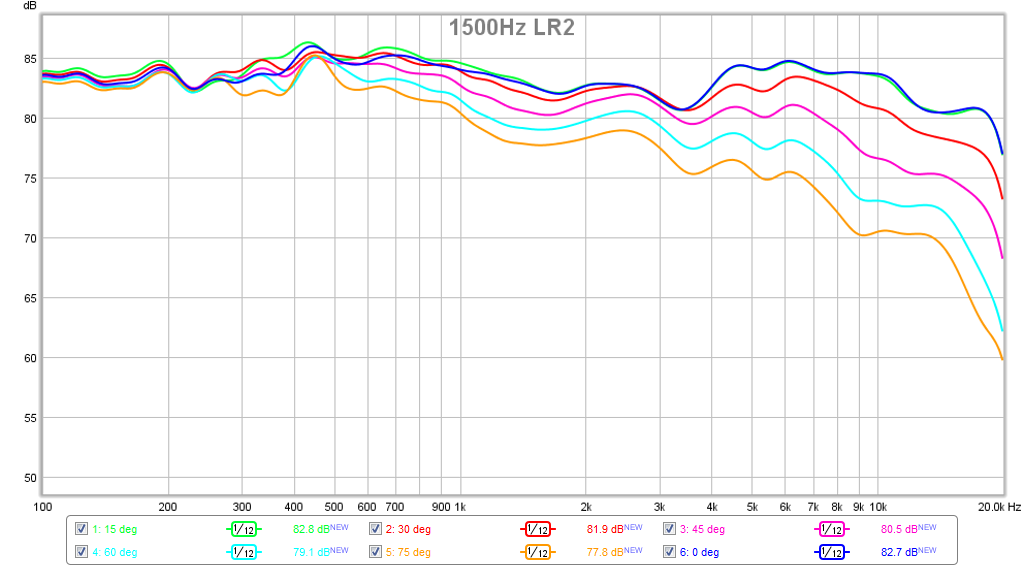
I am listening to a few tracks and it actually sounds pretty good. It's not transient perfect as can be seen in the impulse/step but overall tonal balance is nice and bass is definitely there with no boost applied.
Here is a first cut with a miniDSP. I am using electrical LR2 at 1500Hz low pass on woofer and 1700Hz high pass on tweeter. Strange that there is no cancellation dip - probably because the acoustic shape is not textbook symmetric LR2. A -11dB padding was applied to the tweeter in the waveguide to level match the RS180P. I am using the 4-way advanced plugin, some mild EQ (negative cut only) was applied for shelf and notch filters in a few places.
XO plot:

HD plot (2kHz bump is not so bad):

Impulse and Step:

Phase:

Here is a very rough polar from 0 deg to 75 deg at 0.5m with the above XO. Data presented with 6-cycle frequency dependent window gating (FDW) to remove effects of reflections:

I am listening to a few tracks and it actually sounds pretty good. It's not transient perfect as can be seen in the impulse/step but overall tonal balance is nice and bass is definitely there with no boost applied.
Attachments
Last edited:
That explains why there is no cancellation hole at the xo point. It's going to be important to build the xo following a textbook LR2 overlay.
That explains why there is no cancellation hole at the xo point. It's going to be important to build the xo following a textbook LR2 overlay.
I don't understand that this. Just use the filters that give you the acoustic response you want.
I don't understand that this. Just use the filters that give you the acoustic response you want.
The reason to follow a textbook LR2 is so that a hole can be filled by the mid perfectly - at least the math works out like that. It's quite elegant anytime you can show that a complex set of math equations with a solution that equals 1.
More here:
http://www.diyaudio.com/forums/multi-way/88135-filler-driver-ala-b-o-3.html#post4376492
But the results you show don't follow a "textbook" LR2 response in any way I can see. So I'm not sure whether you're referring to the electric filter or the final acoustic response. The final response is all that matters, so since you don't have that, one of us is confused on how to make the filler driver work. BTW where is the filler driver going to go, I only see a 2-way speaker?
What I am saying is that since all I did was apply an *electrical* LR2. The acoustic crossover may be closer to third or fourth order, hence there was no cancellation for two positive phase drivers. To do the hole filler properly, you need to apply an electrical filter such that the acoustic crossover follows an LR2. That's why I said I will need a textbook function overlay to tweak the minidsp electrical function.
I haven't built the mid hole filler upper baffle and rear chamber yet. It's mounted externally and can be added once I demonstrate a symmetric LR2with cancellation dip. My 3D printer is down and I need it in order to make the waveguide and baffle for the mid.
I haven't built the mid hole filler upper baffle and rear chamber yet. It's mounted externally and can be added once I demonstrate a symmetric LR2with cancellation dip. My 3D printer is down and I need it in order to make the waveguide and baffle for the mid.
As for desinging crossovers with a DSP you should really check out the whitepaper written by Grimm about the development of their own LS1 Speaker, which is awesome in very much all regards.
"Whitepaper about our loudspeaker design concept"
http://www.grimmaudio.com/site/assets/files/1088/speakers.pdf
look at page 6: 2.3 DSP loudspeaker crossovers done right
"Whitepaper about our loudspeaker design concept"
http://www.grimmaudio.com/site/assets/files/1088/speakers.pdf
look at page 6: 2.3 DSP loudspeaker crossovers done right
As for desinging crossovers with a DSP you should really check out the whitepaper written by Grimm about the development of their own LS1 Speaker, which is awesome in very much all regards.
"Whitepaper about our loudspeaker design concept"
http://www.grimmaudio.com/site/assets/files/1088/speakers.pdf
look at page 6: 2.3 DSP loudspeaker crossovers done right
Thanks for that. Several members (Byrtt and others) are doing precisely this, using LR4 and the FIR to correct for phase wrap to end up with transient perfect response. I am using IIR DSP to test out conventional causal filters and then implement in hardware via passive coils/caps/resistors.
I have similar procedure: flatten native response for 2 octaves above and below xo point. Then apply electrical filter to get actual acoustic response to match textbook curve like LR2 or BW2 etc. smooth wide strokes, leave narrow dips alone (can't do anything in passive). Aim for flat minimum phase.
Btw, I did get a response back from PE tech support. They said what I am seeing is native to this driver and not a defect. As we thought.
As I have these drivers already I will proceed given that the H3 with a filter did not seem so bad. But if it doesn't work I might have to get a Satori or Revelator 7in. It's big bucks then though. 🙂
Any driver with a well damped cone resonance should exhibit the distortion you are looking for (all other things equal). SBAcoustics SB17MFC35 would be a good one.
Any driver with a well damped cone resonance should exhibit the distortion you are looking for (all other things equal). SBAcoustics SB17MFC35 would be a good one.
You mean should exhibit the low distortion that I am looking for?
The SB17MFC35 does look very good. Thanks for the tip...
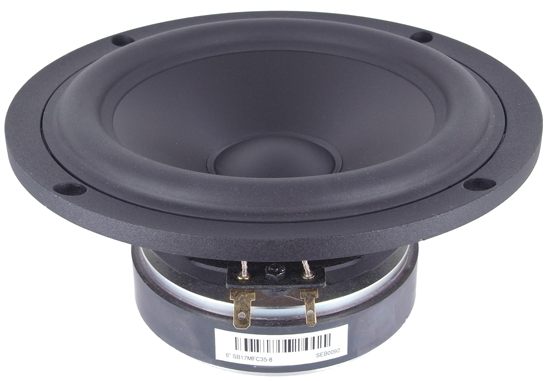
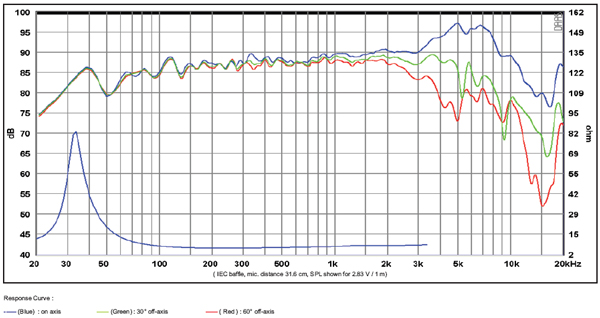
An externally hosted image should be here but it was not working when we last tested it.
I wish the bezel was 0.40in larger in diam and it would be a drop-in replacement.... 🙂 $60 is a good price.
What do the H2/H3 distortion curves look like?
Last edited:
Zman,
Thanks for that - looks very good as well. I think I might try adding some thin strips of Noico to the back of the cone in a pentagonal spoke pattern like a Revelator and see if anything improves. It's reversible.
Thanks for that - looks very good as well. I think I might try adding some thin strips of Noico to the back of the cone in a pentagonal spoke pattern like a Revelator and see if anything improves. It's reversible.
xrk, Wavecor's WF182BD09/10 are paper/glass fiber woofers of 182mm diameter. WF182BD11/12 are the same drivers with truncated frames (165.5mm) for the reduction of either driver center-center spacing or cabinet width.
WF182BD09_10_11_12
WF182BD09_10_11_12
I've tried the paper cone SB and wasn't terribly impressed since IMO it needs the same attention given to the break up as a metal cone. So what's the point? And it's audible without, a dry hiss that is always present at low level.
Another very good candidate is a Scan Discovery.
Another very good candidate is a Scan Discovery.
I have spent a few hours listening to this speaker as an active 2-way with minidsp as the XO and I must say it sounds quite nice despite the higher than desired H3 at 2kHz. As can be seen earlier the H3 at 2kHz doesn't really show up in the measurement when a crossover is implemented.
- Home
- Loudspeakers
- Multi-Way
- RS28F-RS180P-B80 as Hole Filler 3-way
